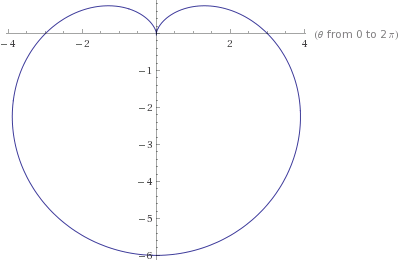4.3 Polar Coordinates
4.3.1 Definition of Polar Coordinates
- The polar coordinate \(p(r,\theta)\) is defined to be Cartesian coordinate \((r\cos\theta,r\sin\theta)\).
- Example Plot the polar coordinates \(p(2,\pi/3),p(\sqrt{2},3\pi/4),p(-2,4\pi/3),p(4,11\pi/6)\).
- Note that every polar coordinate \(p(r,\theta)\) is equal to \(p(r,\theta+k\pi)\) for all even integers \(k\), and equal to \(p(-r,\theta+k\pi)\) for all odd integers \(k\).
4.3.2 Equations Relating Polar and Cartesian Coordinates
- Polar and Cartesian coordinates may be related by the equations \(x=r\cos\theta\), \(y=r\sin\theta\), \(x^2+y^2=r^2\), and \(\tan\theta=\frac{y}{x}\).
- Example Convert the Cartesian coordinate \((-2\sqrt3,2)\) into a polar coordinate.
- Example Convert the polar equation \(r=\frac{1}{\sin\theta-\cos\theta}\), \(\pi/4<\theta<5\pi/4\) into a Cartesian equation.
- Example Convert the Cartesian equation \((x-2)^2+y^2=4\) into a polar equation.
4.3.3 Common Polar Equations
- The equation \(r=R\) is a circle centered at the origin of radius \(R\).
- The equation \(r=D\cos\theta\) is the circle with diameter \(D\) tangent to the \(y\)-axis at the origin.
- The equation \(r=D\sin\theta\) is the circle with diameter \(D\) tangent to the \(x\)-axis at the origin.
- The equation \(\theta=\alpha\) is the line passing through the origin at the angle \(\alpha\).
- The equation \(r\cos\theta=a\) is the vertical line \(x=a\).
- The equation \(r\sin\theta=a\) is the horizontal line \(y=a\).
- Example Sketch the region where \(0<\csc\theta\leq r\leq 2\).
- The equations \(r=a\pm a\cos\theta\) and \(r=a\pm a\sin\theta\) are known as cardioids.
- Example Sketch the cardioid \(r=4-4\sin\theta\).
Review Exercises
- Convert the polar coordinates \(p(\sqrt 3,2\pi/3),p(\sqrt 2,\pi/4),p(2,7\pi/6),p(-\sqrt 3,-\pi/3)\) to Cartesian and plot them in the \(xy\) plane.
- Convert the Cartesian coordinates \((4,-4),(-\frac{3}{2},-\frac{\sqrt 3}{2})\) into polar coordinates.
- Convert the polar equation \(r=\frac{5}{\sqrt{25-9\sin^2\theta}}\) into a Cartesian equation. Name the curve.
- Convert the Cartesian equation \(1-\frac{y}{x^2+y^2}=\frac{3}{\sqrt{x^2+y^2}}\) into a polar equation.
- Convert the Cartesian equation for the line \(y=\frac{x}{\sqrt 3}\) into a polar equation.
- Sketch the region where \(0< 3\sec\theta\leq r\leq 6\cos\theta\). (Hint: Completing the square in \(x^2-6x+y^2=0\) yields \((x-3)^2+y^2=9\).)
- Sketch the cardioid \(r=3+3\sin\theta\).
- Sketch the cardioids \(r=1+\cos\theta\) and \(r=1-\cos\theta\). At what points do they intersect?
- Sketch the “three-leaved rose” \(r=\sin 3\theta\).
- What polar coordinate gives the Cartesian coordinate \((-\sqrt3,1)\)?
- Convert the circle \(x^2+(y-4)^2=16\) into a polar equation.
- What equation gives the curve drawn below?

Textbook References
- University Calculus: Early Transcendentals (3rd Ed)
- 10.3